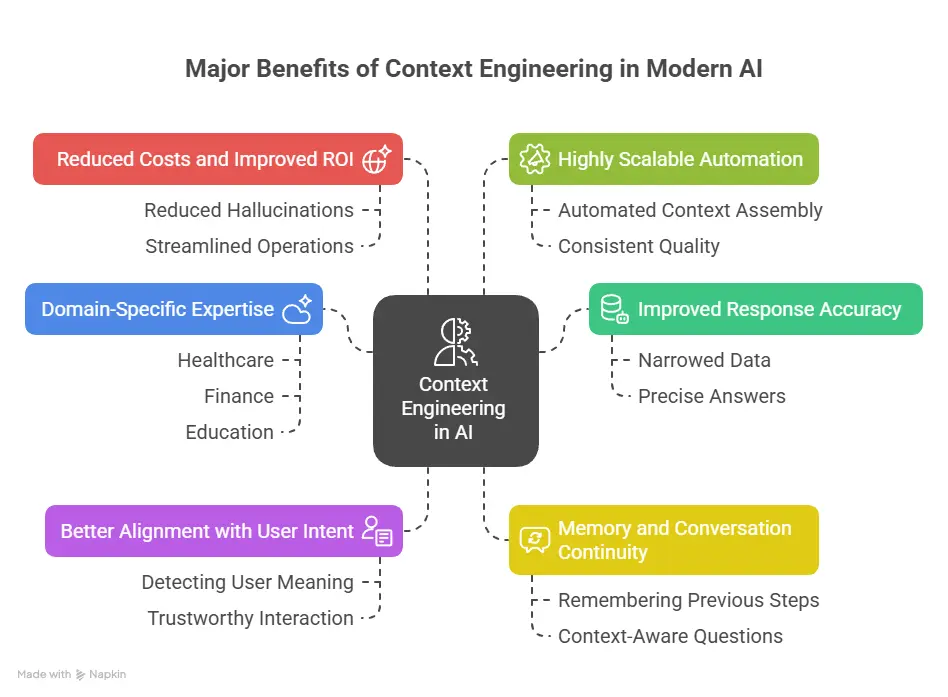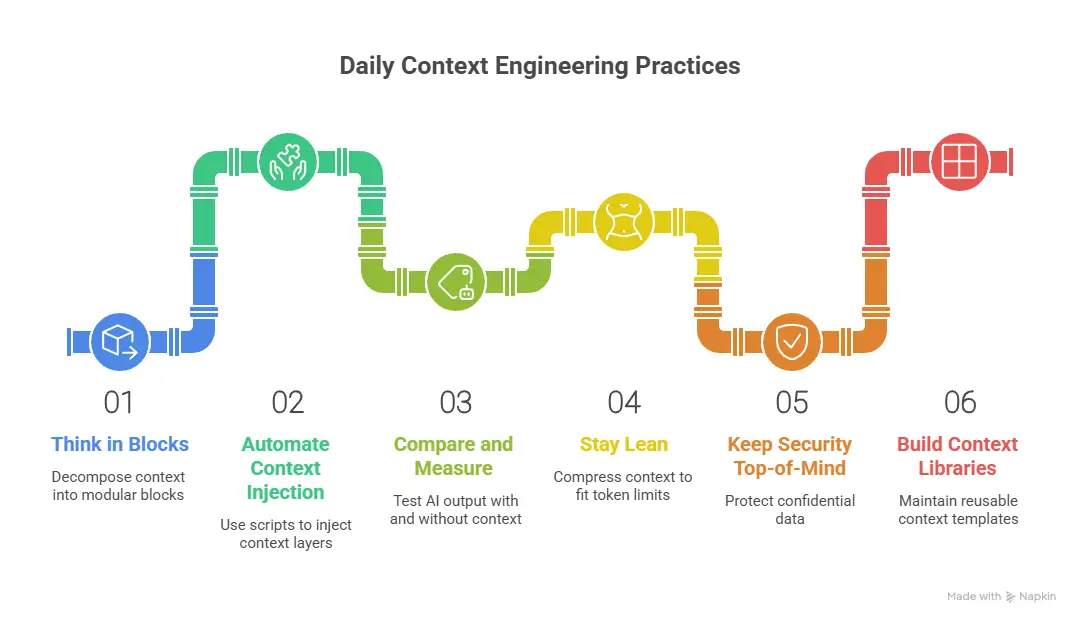Why Context Engineering Matters in Real AI Applications
When deploying AI at scale, generic prompts lead to vague, inaccurate, or even risky outputs. Modern LLMs are incredibly powerful, but they are also stateless by default; unless you deliberately construct and feed them with all the necessary memory, guidelines, and objective-specific instructions, they will produce hit-or-miss answers. That is why context engineering matters:
-
Improves response accuracy by narrowing the model’s focus.
-
Enhances alignment with user intent.
-
Powers domain-specific intelligence for industries such as finance, legal, healthcare, or ecommerce.
-
Adds conversation continuity and long-term memory.
-
Reduces operational risks from “hallucinations” by grounding responses in real data.
-
Decreases costs by reducing the need for human review and repeated clarification.
My Experience: Why I Rely On Context Engineering
As someone who builds and manages automation workflows (using tools like Perplexity or OpenRouter, for instance), I’ve seen firsthand how hit-or-miss AI outputs become when context is missing. A single prompt can only do so much. But when you layer business goals, recent user actions, and workflow stage into the input, AI agents start acting like true collaborators—not just parrots.
For example, when using AI to review a web page, a simple “How can I improve this page?” usually produced generic feedback. By instead injecting a system context with the business goal (“drive conversions—focus on landowners”), messaging guidelines, and then the exact content, and then stating the review objective, the AI could finally generate highly actionable, user-aligned suggestions.
Major Benefits of Context Engineering in Modern AI

1. Improved Response Accuracy
-
By narrowing down the relevant data and context, AI agents make fewer guesses and provide more precise answers.
2. Better Alignment with User Intent
-
AI can detect not just what users say, but what they mean—resulting in more helpful, trustworthy interaction.
3. Memory and Conversation Continuity
-
Proper context engineering enables AI agents to remember previous steps, rules, or even entire workflows, so they can follow up with relevant, context-aware questions or actions.
4. Domain-Specific Expertise
-
AI becomes a true vertical expert when supplied with the correct frameworks, terms, regulations, or best practices for sectors like healthcare, finance, or education.
5. Reduced Costs and Improved ROI
-
Context-optimized AI reduces “hallucinations” (plausible but false answers), requires less human supervision, and streamlines operations.
6. Highly Scalable Automation
-
As context assembly becomes more automated (via APIs, scripts, RAG systems, etc.), teams can deploy multiple agents handling complex, ever-evolving tasks with consistent quality.
How I Engineer Context for Powerful AI Solutions
-
AI-Driven Content Review and Enhancement
Old approach: “How can I improve this web copy?”
Result: Vague, generic feedback.
New approach: Build a system context layer (e.g., “You’re a senior marketer. Our audience is landowners; goal: boost conversions”). Layer in messaging guidelines, paste in the content, state the goal (e.g., “Make this easy for non-technical users”). The AI then gave tips such as simplifying language, emphasizing FAQs for user anxiety, or strengthening the CTA to reflect sector-specific objections. -
Reliable Automation and Quality Control with Layered Context
In AI-driven lead qualification, I keep a running “memory” of recent interactions: scoring criteria, preferences, rules, and terms. When qualifying a web lead, I assemble a system rules block (what makes a good lead), add user-supplied info, then attach my action query (“Should we move this to sales?”). The agent not only scored leads more reliably but began flagging incomplete info, asking for clarification, or offering next-step suggestions.
-
Fast Iteration and Debugging
By maintaining a context log—a record of which layers were used in each run—I quickly pinpointed why an AI gave a weak response (usually a missing rule or guideline). Iteration became trivial: add/move context, test, observe the improvement. This method cut my problem-solving time by more than half.
Best Practices: How to Apply Context Engineering Daily

-
Think in Blocks: Always decompose the context—system instructions, recent memory, current task, and data. Inject them as clear, modular context blocks. This helps in debugging and auditing too.
-
Automate Where Possible: Use scripts, APIs, or workflow engines to automatically gather, order, and inject context layers.
-
Compare and Measure: Test your AI agent’s output with and without key context layers to see the difference and quantify gains.
-
Stay Lean: Compress or abstract context to fit within token limits—summarize history, focus only on relevant data for complex tasks.
-
Keep Security Top-of-Mind: Never share confidential business or user data; use abstracted or anonymized context especially in multi-user or public-facing environments.
-
Build Context Libraries: For frequent tasks (e.g., customer support, marketing, legal review), maintain reusable context templates to save time and reduce errors.
How Context Engineering Solves Common AI Pain Points
-
Hallucination Reduction: Well-grounded context slashes hallucination rates by up to 90%.
-
Higher Task Success Rate: Companies using dynamic, layered context see up to tenfold improvement in task completion.
-
Lower Operational Costs: Fewer retries, higher first-pass accuracy, and reduced agent handover result in substantial savings.
-
Enhanced Human-AI Collaboration: Context-powered AI agents become genuine virtual teammates, adapting to user work patterns and anticipating needs.
Frequently Asked Questions about Context Engineering
Q1. How does context engineering actually differ from advanced prompt engineering?
A: Prompt engineering is about the input phrasing or question construction. Context engineering goes far deeper: it involves curating and assembling all the background data, system rules, instructions, user history, and up-to-the-minute information required for optimal AI performance—often using automated or dynamic assembly.
Q2. Is context engineering only relevant for enterprise AI?
A: No, it’s valuable for everyone from solo creators to large firms. Any workflow where AI must remember, adapt, or leverage extra data benefits from proper context design—whether you’re building a virtual assistant, a research tool, or automating customer support.
Q3. What kinds of context should I include for the best results?
A: Focus on system instructions, organizational knowledge, user preferences and history, current task data, and security guidance. For advanced workflows, also consider dynamic retrieval of real-time information (RAG), API outputs, and domain-specific templates.
Q4. What tools help automate or manage context engineering?
A: Popular approaches involve the use of middleware scripts, retrieval pipelines (RAG), context management APIs, and workflow orchestration tools. Tools like LangChain and custom agent frameworks are common for automated context assembly.
Q5. How can I ensure my context engineering practice is secure and compliant?
A: Always abstract or redact confidential user or business data, especially when using cloud models or public AI endpoints. Build compliant workflows by default—no sensitive details, use role-based or anonymized context blocks, and document all data flows.
Q6. Does context engineering also benefit non-conversational AI (like vision or code)?
A: Absolutely. Context can include user guidance, task instructions, previous outputs, or live external data—improving the reliability and specificity of AI for tasks ranging from image recognition to automated coding or analytics.
Q7. What is the future of context engineering?
A: Context engineering will soon become a fundamental AI skill—on par with database design, APIs, or cybersecurity. It’s set to become the main differentiator for enterprise-ready, domain-smart, and trustworthy AI systems across industries.
Final Thoughts
Mastering context engineering is the difference between generic, unreliable AI and business-class, goal-driven AI that consistently delivers exceptional results. It doesn’t just improve the reliability of large language models; it transforms them into smart collaborators ready for the complex, dynamic challenges of the real world. If you want to unlock the full power of AI agents—whether as a business leader, developer, or creative professional—start thinking about the contexts your AI interacts with, not just the prompts.
Want more hands-on frameworks or context-engineering templates? Reach out, and we can explore practical ways to make context engineering part of your AI workflow—whether you’re just starting out or deploying at enterprise scale.
Resource Center
These aren’t just blogs – they’re bite-sized strategies for navigating a fast-moving business world. So pour yourself a cup, settle in, and discover insights that could shape your next big move.
How Serious Are the New React & Next.js RCE Vulnerabilities?
The JavaScript ecosystem woke up to a major security alarm this week. Two newly disclosed vulnerabilities — CVE-2025-55182 (React) and CVE-2025-66478 (Next.js) — expose millions of applications to unauthenticated [...]
How can businesses integrate ChatGPT-style services into their existing workflows?
In today’s competitive landscape, organisations are under constant pressure to innovate, accelerate delivery, and streamline operations. As businesses re-evaluate traditional processes, ChatGPT-style AI services are emerging as one of [...]
Are AWS Frontier AI Agents Redefining the Future of Autonomous Software Development?
In our two decades of engineering experience, we’ve witnessed dozens of technological waves—cloud adoption, container orchestration, serverless evolution, full-stack automation, LLM assistance, and more. But every once in a [...]

